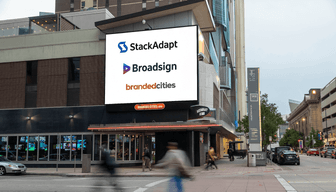We’re excited to welcome Arno Buskop to the Broadsign team as our new Senior Director of Data Strategy. Arno joins us from GroupM’s Kinetic, where he spent nearly 15 years at the intersection of data, technology, and research in out-of-home (OOH) media. With deep experience in data-driven planning, measurement, and software development, Arno has helped shape how modern OOH campaigns are executed and evaluated.
As he steps into this new role at Broadsign, Arno brings with him a sharp perspective on the future of OOH and how data can drive smarter decisions, stronger outcomes, and greater accountability across the ecosystem.
We sat down with Arno to hear more about his vision for the industry, what excites him about the medium, and why now is a pivotal moment for data strategy.
What excites you most about working in out-of-home advertising today?
What excites me is that, even after two decades of working in OOH measurement, research, and technology, the puzzle still feels unsolved. That ongoing challenge, bringing all the moving parts together, is what keeps me motivated. At the same time, the pace of change is accelerating. Data and technology are evolving rapidly, and the art (expertise) and science (data) of OOH are converging more than ever. As the art increasingly integrates into platforms, it’s critical that we stay focused on doing the right thing and delivering real value for advertisers.
That creates a powerful moment of opportunity. Broadsign holds a unique position in the market—widely adopted and deeply embedded in the core of digital ad delivery and optimization. We now have the chance to build on that foundation, in collaboration with clients and partners, to help shape what’s next for the entire OOH industry.
In your opinion, what defines a strong data strategy in OOH, and where do you see the biggest opportunities for growth?
A strong OOH data strategy aligns planning, activation, and measurement throughout the entire ecosystem. It begins with trustworthy audience data, both deterministic and modelled, and layers in contextual signals unique to the physical nature of the OOH environment. But it’s not just about collecting data; the real value comes from connecting it in meaningful ways that drive better outcomes.
The biggest growth opportunities lie in predictive capabilities, more intelligent targeting, and real-time creative optimization. AI has a major role to play in making these complex scenarios more understandable. In the near future, AI will begin to reshape how we forecast audiences, validate delivery, and dynamically adjust campaigns.
What are some of the key challenges brands face when leveraging data in OOH, and how can the industry address them?
The biggest challenges stem from fragmentation across methods, data standards, and practices. Many markets, and therefore brands, still face inconsistent audience definitions, limited transparency, and unreliable impression validation. There’s also a clear gap between the desire for seamless omnichannel execution and the current realities of how OOH fits into that broader landscape.
To move forward, we need shared benchmarks, improved data interoperability, and stronger collaboration across the value chain. As programmatic investment continues to grow, fraud prevention, brand safety, and data accuracy must become industry-wide priorities.
Where does measurement stand today, and how should it evolve moving forward?
Measurement in OOH has come a long way, but it still varies by market, vendor, and methodology. We’ve moved beyond basic reach proxies and are beginning to validate impressions and connect exposure to outcomes. Still, accountability remains inconsistent.
There’s a clear need for transparent, shared metrics and standards that both buyers and sellers can align on. We also need to be honest about what’s modelled, what’s observed, and what’s assumed. That level of clarity becomes especially important when combining data sources or building attribution models.
Ultimately, measurement should help OOH close the loop from planning to delivery to performance. It’s not about finding one perfect number; it’s about developing frameworks that build confidence, reduce friction, and enable brands to invest with trust.
At the same time, OOH can take inspiration from digital channels by adopting a smarter, more agile mindset—planning more effectively, optimizing in real time, and consistently proving value. This includes using better segmentation, dynamic delivery strategies, and real-time adjustments.
However, the goal isn’t to replicate digital. OOH’s strength lies in its physical presence, contextual relevance, and brand-safe, emotionally resonant environments. The real opportunity is in combining those unique qualities with digital intelligence.
How do you see the medium integrating more seamlessly with omnichannel media strategies?
The market is demanding it. Agencies are consolidating planning and driving toward true omnichannel execution. For OOH to thrive in this environment, it must integrate with all major buying platforms, align on metrics, and communicate in the same terms as other media channels.
At the same time, we need to proactively assert our influence and show that we’re equipped to navigate complexity, especially as other channels continue to introduce new priorities that can easily shift attention elsewhere.
With the continued shift toward digitization and programmatic buying, which trends or technologies are you most eager to see evolve?
I’m excited about AI and automation, not just for optimization but for their potential to reduce manual effort across the entire ecosystem. We need to use the industry’s expertise to build better plans and execute more effectively, not waste it on repetitive tasks. I’m also closely watching how mobility and location data can deepen our understanding of audiences and improve delivery. In addition, I see creative and media planning beginning to converge, which presents a major opportunity for platforms like Broadsign that sit at the heart of ad delivery.






